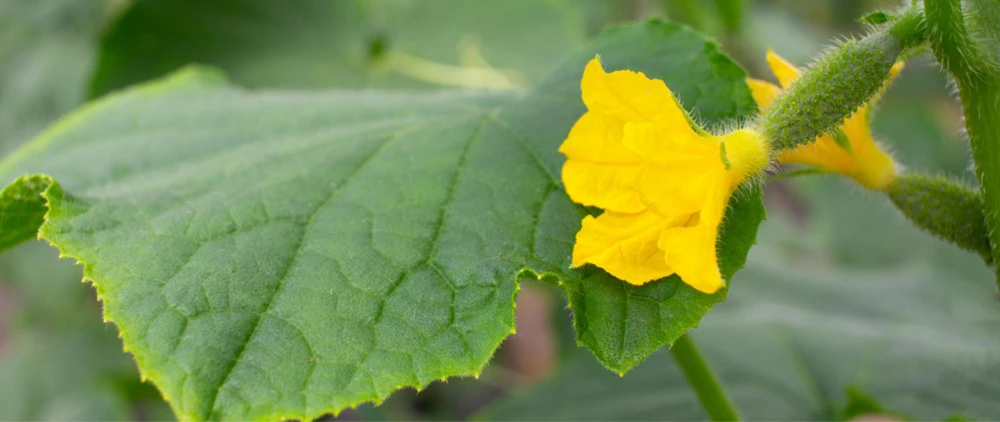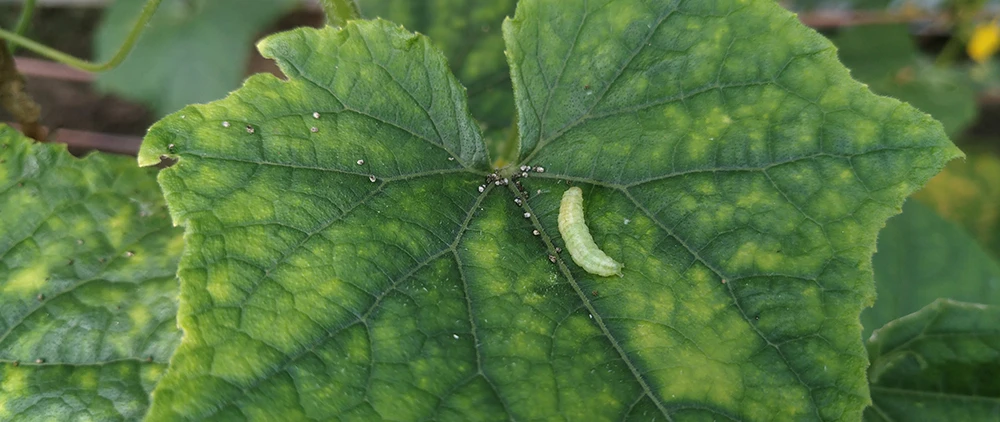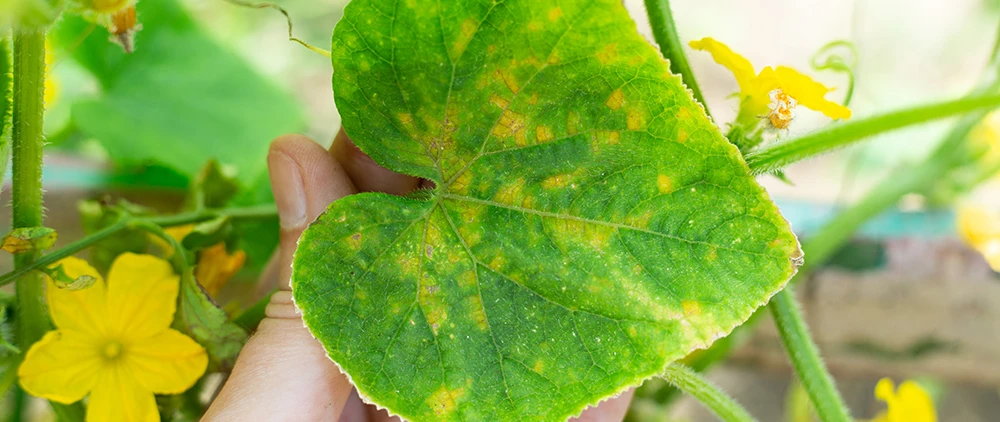7 Common Causes of Yellow Cucumber Leaves and Quick Fixes
It can be pretty discouraging if one week your cucumber plants are looking lush and healthy, and the next, their leaves start fading to the sad shade of yellow.
This is actually one of the most common issues cucumber growers run into. And when it shows up, it usually brings a lot of questions: Is it too much water? Not enough? A pest? A disease?
There are a few different things that can cause yellow leaves, but most of them are manageable once you know what to look for.
In this post, we’ll talk about 7 common reasons why cucumber leaves turn yellow, and we’ll provide some tips to help bring your plants back to life.
When to Be Concerned About Yellowing Leaves
Not all yellow leaves are a bad sign. It’s totally normal for the oldest leaves at the bottom of the plant to turn yellow and fall off as the cucumber plant grows. This just means the plant is focusing its energy on producing new leaves and fruit.
But if you notice many leaves turning yellow, especially newer ones, or if the yellowing comes with other issues like wilting, slow growth, or visible pests, that’s a sign something’s wrong. In that case, your plant needs some immediate care and attention.
The 7 Most Common Causes and Quick Fixes
Aside from the natural shedding of old leaves, yellowing cucumber leaves are usually a sign that something's wrong. Here are 7 common reasons why your cucumber leaves might be turning yellow, and some quick, simple fixes to help your plants bounce back.
Nutrient Deficiency
Cucumber plants are heavy feeders, meaning they require a steady supply of nutrients to stay healthy. One of the most common causes of yellowing leaves is a deficiency in essential nutrients, especially nitrogen, magnesium, or iron.

Nitrogen (N) Deficiency
Symptoms:
Older, lower leaves turn a uniform pale yellow. The yellowing typically starts at the leaf tips and edges, then spreads inward.
What to Do:
Apply a nitrogen-rich fertilizer to replenish the nutrients. Options include fish emulsion or a balanced liquid fertilizer with a higher first number in the N-P-K ratio (e.g., 10-5-5). For faster results, use a foliar spray to deliver nitrogen directly to the leaves.
Magnesium (Mg) Deficiency
Symptoms:
Yellowing occurs between the leaf veins, a condition known as interveinal chlorosis, while the veins remain green. This usually starts on older leaves.
What to Do:
Apply Epsom salts (magnesium sulfate) to the soil or dissolve it in water for a foliar spray to quickly correct the deficiency.
Iron (Fe) Deficiency
Symptoms:
Similar to magnesium deficiency, but it affects young, new leaves first. Yellowing appears between the veins, which stay green.
What to Do:
Apply a chelated iron supplement either directly to the soil or as a foliar spray for quicker absorption.
Watering Issues
Improper watering, whether too much or too little, can stress cucumber plants and cause their leaves to turn yellow.
Underwatering
Symptoms:
Leaves may wilt, turn yellow, become dry and crispy, and eventually fall off. The soil will feel very dry to the touch.
What to Do:
Water the plant deeply and thoroughly, making sure the moisture reaches the root zone. Allow the water to soak in slowly so it penetrates the soil rather than running off.
Overwatering
Symptoms:
Leaves become droopy, soft, and evenly yellow, often starting with the lower leaves. The soil may feel constantly wet or soggy, which can lead to root rot.
What to Do:
Let the soil dry out significantly before watering again. If the plant is in a container, check that the drainage holes are clear to prevent water from pooling at the bottom.
Inadequate Lighting
Light is essential for photosynthesis, and cucumber plants thrive in bright, direct sunlight. Without enough light, they struggle to grow and stay healthy.
Symptoms:
Plants may appear pale, leggy, and weak, with yellowing leaves, especially on the lower parts. In severe cases, the plant may shed these leaves to conserve energy.
What to Do:
Move outdoor or container plants to a sunnier spot where they can receive at least 6 to 8 hours of direct sunlight each day.
For indoor plants, use a full-spectrum LED grow light designed for strong vegetative growth. If you're already using grow lights, try increasing the intensity or extending the duration to ensure the plant gets enough light.
Pest Infestations
Pests can seriously harm cucumber plants by feeding on their leaves and stems, sucking out vital sap, and spreading diseases. Even a mild infestation can weaken the plant, causing yellowing leaves and stunted growth.

Cucumber Beetles
Symptoms:
Small, striped beetles that feed on leaves and flowers. They also transmit bacterial wilt, a dangerous disease that can quickly wipe out your entire cucumber crop.
What to Do:
Use row covers to protect young plants and apply insecticidal sprays specifically formulated to target cucumber beetles. Act quickly, these pests can cause rapid damage.
Aphids
Symptoms:
Tiny green, black, or white insects that cluster on the undersides of leaves. They cause leaves to yellow, curl, and distort, severely slowing plant growth.
What to Do:
Control aphids by introducing beneficial insects like ladybugs, spraying them off with water, or using insecticidal soap for more persistent infestations.
Squash Bugs
Symptoms:
Small yellow-green or white spots (called stippling) on the leaves. Over time, the leaves may become tattered and yellow.
What to Do:
For light infestations, spray with neem oil or insecticidal soap, making sure to cover all affected areas thoroughly.
Spider Mites
Symptoms:
Tiny pests that cause fine yellow or white spots on leaves. These spots can merge into larger yellow patches. Undersides of leaves may look dusty or dirty due to webbing and debris.
What to Do:
Treat with neem oil or insecticidal soap, ensuring thorough coverage of both upper and lower leaf surfaces.
Diseases Issues
Cucumber plants are prone to various diseases, including fungal, viral, and bacterial infections. These illnesses often cause leaves to turn yellow and may lead to spots, blotches, wilting, or even plant death if left untreated.
Downy Mildew
Symptoms:
Look for angular yellow spots on the leaves, typically limited by the leaf veins. As the disease progresses, affected areas turn brown and crispy. In humid conditions, you may notice a dark, fuzzy mold on the undersides of the leaves.
What to Do:
If your plant is infected, it's best to remove and destroy it promptly to prevent the mildew from spreading to nearby plants.

Tobacco Ringspot Virus
Symptoms:
Tiny yellow spots appear on the leaves. New growth may show mottling and deformities similar to those caused by cucumber mosaic virus.
What to Do:
- Avoid overcrowding plants to promote good air circulation.
- Keep leaves dry by watering at the base and not overhead.
- Remove and dispose of any affected leaves or stems to limit the spread.
Mosaic Virus
Symptoms:
Leaves display a yellow or green mosaic-like pattern or mottling. They may become twisted, crinkled, deformed, or stunted. Infected leaves can curl either upward or downward.
What to Do:
Unfortunately, there’s no cure for the mosaic virus. The best course of action is to remove and destroy infected plants to prevent the virus from spreading to healthy ones.

Transplant Shock and Root Damage
When cucumber plants are moved to a new location, they can suffer from transplant shock due to disruption of their root systems.
Symptoms:
Look for signs such as yellowing leaves, wilting, or stunted growth, these typically appear soon after transplanting.
What to Do:
- Keep the soil consistently moist, but avoid overwatering.
- Protect the plants from direct sunlight for 3 to 5 days to help them adjust.
- Use a root stimulator that contains mycorrhizal fungi to support healthy root development and encourage faster recovery.
Environment Stress
While pests and diseases are common concerns, environmental stress is often an overlooked cause of yellowing cucumber leaves. Factors such as extreme temperatures and sudden weather changes can significantly affect plant health.
Symptoms:
When temperatures drop below 10°C, plants may show yellowing and stunted growth. Prolonged exposure to temperatures above 32°C can cause leaves to wilt, turn pale yellow, or develop dry, crispy edges.
What to Do:
Create a more stable growing environment by using row covers, shade cloth, or humidity trays. If you're growing cucumbers in containers, move them to sheltered areas during extreme weather conditions to minimize stress.
|
Cause |
Symptoms |
Quick Fix |
|
1. Nutrient Deficiency |
|
|
|
Nitrogen (N) |
Older, lower leaves turn uniformly pale yellow, starting at the tips and edges |
Apply nitrogen-rich fertilizer (fish emulsion or balanced liquid fertilizer 10-5-5); use foliar spray for faster results |
|
Magnesium (Mg) |
Yellowing between leaf veins (interveinal chlorosis) while veins stay green, starts on older leaves |
Apply Epsom salts to the soil or as a foliar spray |
|
Iron (Fe) |
Similar to Mg deficiency, but affects young leaves first; yellowing between the veins |
Apply chelated iron supplement to the soil or as a foliar spray |
|
2. Watering Issues |
|
|
|
Underwatering |
Leaves wilt, turn yellow, become dry and crispy; the soil feels very dry |
Water deeply and thoroughly, ensuring moisture reaches the root zone |
|
Overwatering |
Leaves droopy, soft, evenly yellow (starting with lower leaves); soil constantly wet/soggy |
Let the soil dry significantly before watering; check drainage holes |
|
3. Inadequate Lighting |
Plants pale, leggy, weak with yellowing leaves (especially lower parts); may shed |
Move to a sunnier spot (6-8 hours of direct sunlight); use full-spectrum LED grow lights for indoor plants |
|
4. Pest Infestations |
|
|
|
Cucumber Beetles |
Small striped beetles on leaves/flowers; transmit bacterial wilt |
Use row covers and insecticidal sprays; act quickly |
|
Aphids |
Tiny insects cluster under leaves; leaves yellow, curl, distort |
Introduce ladybugs, spray with water, or use insecticidal soap |
|
Squash Bugs |
Small yellow-green/white spots (stippling); leaves become tattered and yellow |
Spray with neem oil or insecticidal soap |
|
Spider Mites |
Fine yellow/white spots that merge into larger patches; webbing on the undersides |
Treat with neem oil or insecticidal soap on both leaf surfaces |
|
5. Disease Issues |
|
|
|
Downy Mildew |
Angular yellow spots limited by veins; turn brown and crispy; dark fuzzy mold underneath |
Remove and destroy infected plants to prevent the spread |
|
Tobacco Ringspot Virus |
Tiny yellow spots; new growth shows mottling and deformities |
Avoid overcrowding, keep leaves dry, and remove affected parts |
|
Mosaic Virus |
Yellow/green mosaic pattern; leaves twisted, crinkled, deformed, stunted |
No cure - remove and destroy infected plants |
|
6. Transplant Shock & Root Damage |
Yellowing leaves, wilting, and stunted growth appear soon after transplanting |
Keep soil consistently moist (don't overwater); protect from direct sun for 3-5 days; use root stimulator with mycorrhizal fungi |
|
7. Environmental Stress |
Temperatures below 10°C cause yellowing and stunted growth; above 32°C cause wilting, pale yellow leaves, crispy edges |
Use row covers, shade cloth, or humidity trays; move container plants to sheltered areas during extreme weather |

